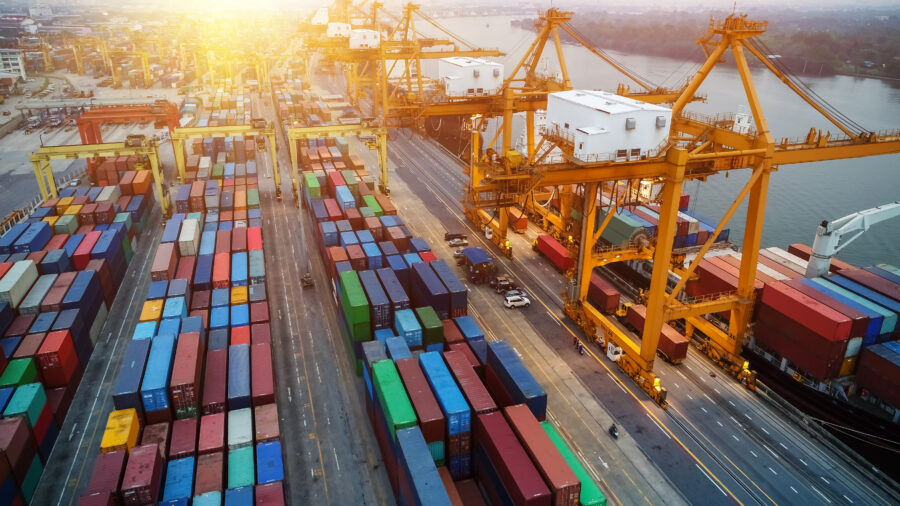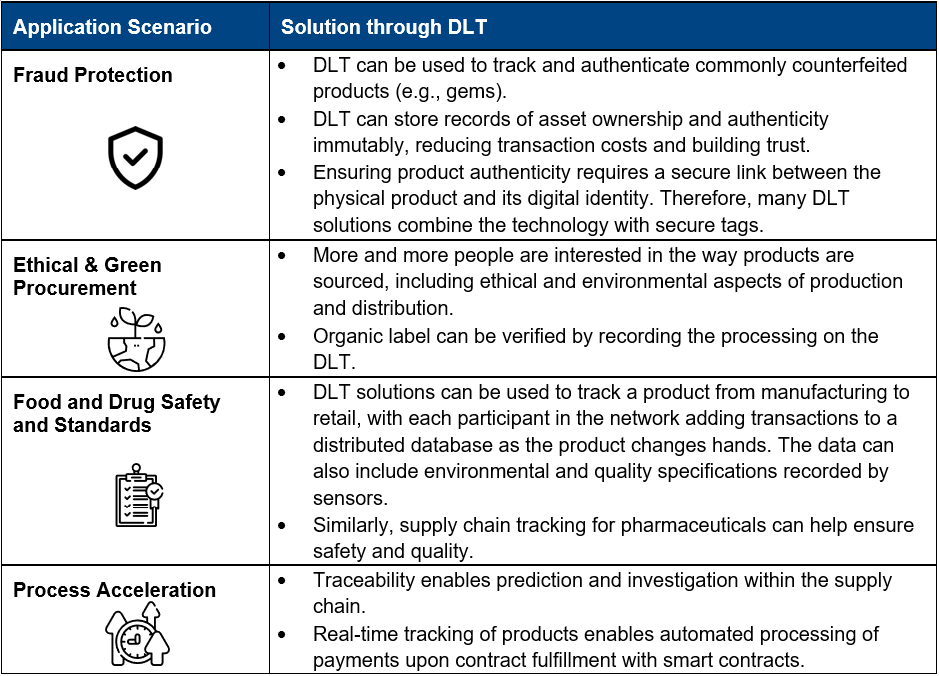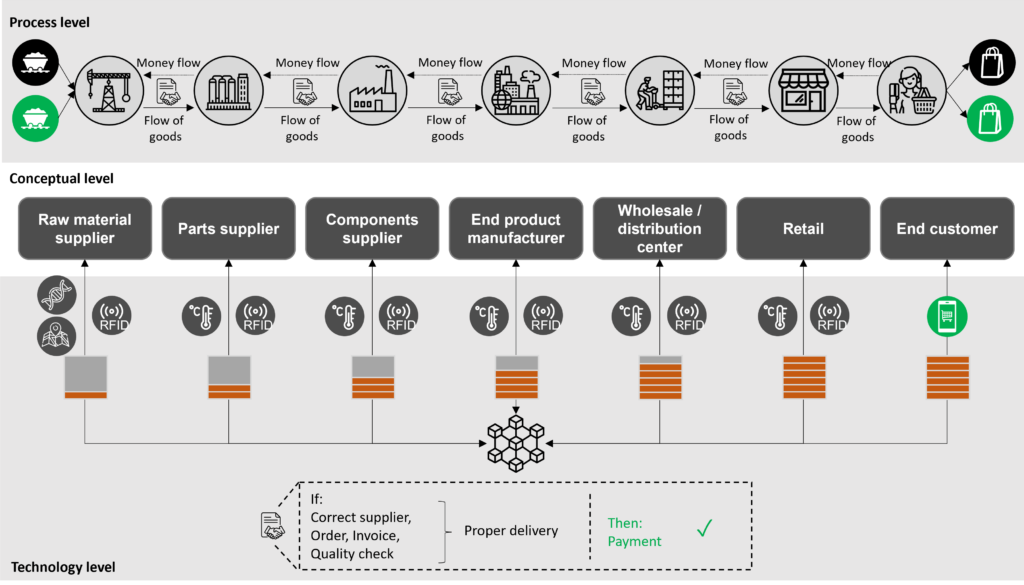
DLT in the Supply Chain: Can It Guarantee Traceability?
In the industrial sector, advanced interconnection between customers, products and value chains poses major challenges for companies. The credibility of data in the supply chain is often questioned. Using distributed ledger technology in this context is proving to be a promising use case in various industries.
A company’s supply chain management attempts to achieve linkage and coordination between the processes of other suppliers, customers, and the organization itself [2]. It involves all movements and storage of raw materials, work-in-process and finished goods from origin to point of consumption [3].
For this purpose, companies worldwide already operate computerized enterprise resource planning (ERP) or use supply chain management software. “Analog gaps” in the corporate infrastructure prevent digital traceability, which is relevant for fraud prevention. [1]
Traceability in the Supply Chain
In recent years, there has been an increased focus on product traceability in food supply chains. Around the year 2000, the many tragic and costly food scandals that received major media attention around the world at the time were the main driver for improved food traceability. [11]
As a result, traceability requirements were incorporated or strengthened in national legislation and in commercial standards for food production. In recent years, electronic systems and standards for food traceability have greatly improved. This has led to potential benefits of investing in better traceability systems beyond risk reduction and compliance. [11]
These potential benefits typically include [11]:
- Lower costs and less effort due to better information logistics and reduced internal data entry
- Lower costs and less work associated with information sharing between business partners through better integration of electronic systems
- Access to more accurate and timely information needed to make better decisions about how and what to produce
- Competitive advantage through the ability to document desirable product attributes, especially those related to sustainability, ethics, and low environmental impact
DLT Application in the Supply Chain in the Field of Traceability
The supply chain is one of the main application domains for linking distributed ledger technology (DLT) and IoT because intra- and inter-enterprise connectivity of resources and goods is needed. States can be exchanged or interactions negotiated via a secure storage location. In this context, DLT acts as an enabler for the communication of IoT devices as well as the verifiable transmission of information. [5]
DLT is already being used in the following application scenarios:

Source: own representation based on [7].
One example of a platform that is already being used to increase efficiency in ocean freight transport is the TradeLens platform from IBM and Maersk. It allows all parties involved in the shipment of a good to be networked, check the progress of the shipment and react promptly to delays and changes. They also have access to all trade documents relevant to them, which they can view or edit depending on the level of authorization. All transactions and changes are stored in a tamper-proof manner on a distributed ledger. [8]
Guide for Using DLT in the Supply Chain in the Area of Traceability
One of the biggest challenges in implementing a DLT system is its usual complexity. For example, all stakeholders in the supply chain must work together to adopt and implement the technology to make it successful as desired. Since DLT technology is still in the early stages of development, there is a general lack of standards for implementation [4]. In this regard, all stakeholders in the “end-to-end DLT-enabled supply chain” should participate to realize the full potential of the technology. [10]
Source: own illustration
Fig. 1 shows a generic model with three levels for a transparent supply chain.
The conceptual level represents a cross-company supply chain [12]. In this generic model, individual supply chain procedures could also be omitted. The seven steps listed (from raw material supplier to end customer) are to be understood as examples.
In the process level, the flow of goods is shown from left to right. In addition, the flow of money is shown in payment for the goods. This flow of money could also be executed automatically by a smart contract in B2B business, as symbolized by a “contract” in the graphic. The symbolized raw materials on the left and the end product on the right represent that the end customer can trace which products have been generated sustainably / legally (shown in green), for example. This is information that can be communicated to customers when they purchase their food.
At the technology level, the DLT and IoT devices used are shown. All companies in the supply chain are equally authorized to store associated information of a product on the DLT. A tamper-proof input source, such as a DNA analysis for diamonds, can be used to legitimize the origin of the raw material in an even more precise and tamper-proof manner. Alternatively, another independent source of information, such as GPS signal could be added. This could show that, for example, a fish was not fished from illegal waters.
During the processing of a product along the supply chain, IoT devices can be used to measure, for example, the temperature or pressure in a vessel. This measurement of temperature has been described in the supply chain of pharmaceuticals, where it is even required by regulation. By using RFID tags, the transfer of goods can be recorded on the one hand and the location on the other. Finally, the end customer can view the information relevant to him in the database (shown in orange) in the retail store by scanning a QR code.
DLT Compared to a Centralized System
DLT could create a common platform and standards for collaboration. It is seen by the authors as a potential missing piece in collaboration between companies [8]. DLT enables chronological storage of transactions through timestamps. All stakeholders with access to the DLT can view the transactions.

Source: own representation based on [4].
With the help of smart contracts, partners of a blockchain network can define framework conditions for their relationships in a binding manner. Together with IoT sensors, payment transactions can be triggered directly, e.g., when goods are received. The administrative effort from invoicing to payment instruction could be significantly reduced. These processes could be automated, based on the agreements made in the smart contract, and would therefore no longer need to be executed individually or manually. [6]
Conclusion
DLT development is advancing rapidly, making it difficult to predict the best choice for the future. DLT has hardly been applied in the supply chain, so strong motivation, close collaboration, and system integration are required to work smoothly. However, more and more people are interested in the way products are sourced, including ethical and environmental aspects of production and distribution. Accordingly, in selected application scenarios, it makes sense to use DLT instead of traditional data management software.
This blog post is an excerpt from the bachelor thesis “Presentation of the Potential Benefits of Distributed Ledger Technology in the Supply Chain in the Area of Traceability” by Rico Schmid. It involved a comprehensive literature review and the analysis of ten application examples from the food, mining, manufacturing and pharmaceutical industries by means of a morphological analysis. The thesis was awarded by the Eastern Switzerland University of Applied Sciences as the best bachelor thesis in the field of business informatics.
